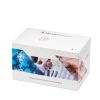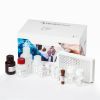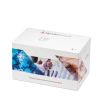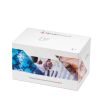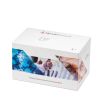FHR-3, Human, ELISA kit – 2 x 96 det. - HK3005-02
Catalog #
HK3005-02
1.359,00 €
Human Complement Factor H-related protein 3 (FHR-3) is a crucial glycoprotein within the complement regulatory protein family. Synthesized mainly by the liver, FHR-3 is also produced by immune cells like monocytes and macrophages. This protein manifests in the plasma as multiple glycosylated forms, ranging between 35 to 56 kDa. Sharing structural similarities with Complement Factor H (CFH), FHR-3 is a significant player in the complement system's regulatory network, particularly within the alternative pathway.
The exact role of FHR-3 in complement regulation remains to be fully deciphered. Preliminary studies suggest it has weak cofactor activity, potentially enhancing FH cofactor activity, and shows a limited inhibitory effect in hemolytic assays using FH-depleted serum. However, further research is needed to validate these findings.
In terms of clinical implications, aberrations in human FHR-3 expression or function are associated with diseases such as atypical hemolytic uremic syndrome (aHUS), age-related macular degeneration (AMD), and systemic lupus erythematosus (SLE). In these conditions, improper complement activation and tissue deposition play a role in disease pathology.
The role of FHR-3 in the Alternative Pathway underscores its importance in disease mechanisms. Its significant impact makes it a promising therapeutic target for diseases affected by complement dysregulation. Understanding FHR-3's involvement in these processes is vital for developing effective strategies to control complement-driven diseases. FHR-3 can be measured with our HK3005 assay, designed to precisely quantify this intriguing glycoprotein.
The exact role of FHR-3 in complement regulation remains to be fully deciphered. Preliminary studies suggest it has weak cofactor activity, potentially enhancing FH cofactor activity, and shows a limited inhibitory effect in hemolytic assays using FH-depleted serum. However, further research is needed to validate these findings.
In terms of clinical implications, aberrations in human FHR-3 expression or function are associated with diseases such as atypical hemolytic uremic syndrome (aHUS), age-related macular degeneration (AMD), and systemic lupus erythematosus (SLE). In these conditions, improper complement activation and tissue deposition play a role in disease pathology.
The role of FHR-3 in the Alternative Pathway underscores its importance in disease mechanisms. Its significant impact makes it a promising therapeutic target for diseases affected by complement dysregulation. Understanding FHR-3's involvement in these processes is vital for developing effective strategies to control complement-driven diseases. FHR-3 can be measured with our HK3005 assay, designed to precisely quantify this intriguing glycoprotein.
| Datasheet URL | https://www.hycultbiotech.com/wp-content/uploads/2024/03/HK3005-1223.pdf |
|---|---|
| Quantity | 2x96det. |
| Working volume | 100 µl/well |
| Species | human |
| Cross reactivity | Monkey - No, Mouse - No, Rat - No |
| Alias | Complement Factor H-related protein 3 |
| Principle | The human FHR-3 ELISA is a ready-to-use solid-phase enzyme-linked immunosorbent assay based on the sandwich principle with a working time of 1 hour and 15 minutes. The efficient format of a plate with twelve disposable 8-well strips allows free choice of batch size for the assay. Samples and standards are incubated in microtiter wells coated with antibodies recognizing human FHR-3. Peroxidase-conjugated antibody will bind to the captured FHR-3. Peroxidase-conjugate will react with the substrate, tetramethylbenzidine (TMB). The enzyme reaction is stopped by the addition of oxalic acid. The absorbance at 450 nm is measured with a spectrophotometer. A standard curve is obtained by plotting the absorbance (linear) versus the corresponding concentrations of the human FHR-3 standards (log). The human FHR-3 concentration of samples, which are run concurrently with the standards, can be determined from the standard curve. |
| Storage and stability | Product should be stored at 4 °C. Under recommended storage conditions, product is stable for at least six months. |
| Precautions | For research use only. Not for use in or on humans or animals or for diagnostics. It is the responsibility of the user to comply with all local/state and federal rules in the use of this product. Hycult Biotech is not responsible for any patent infringements that might result from the use or derivation of this product. |
| Disease | Autoimmunity, Infectious diseases, Nephrology, Tumor immunology |
| Principle: | The human FHR-3 ELISA is a ready-to-use solid-phase enzyme-linked immunosorbent assay based on the sandwich principle with a working time of 1 hour and 15 minutes. The efficient format of a plate with twelve disposable 8-well strips allows free choice of batch size for the assay. Samples and standards are incubated in microtiter wells coated with antibodies recognizing human FHR-3. Peroxidase-conjugated antibody will bind to the captured FHR-3. Peroxidase-conjugate will react with the substrate, tetramethylbenzidine (TMB). The enzyme reaction is stopped by the addition of oxalic acid. The absorbance at 450 nm is measured with a spectrophotometer. A standard curve is obtained by plotting the absorbance (linear) versus the corresponding concentrations of the human FHR-3 standards (log). The human FHR-3 concentration of samples, which are run concurrently with the standards, can be determined from the standard curve. |
|---|


